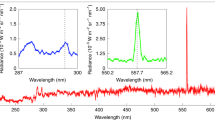Abstract
THE initial detection of the OH lines in the interstellar medium involved the two strongest lines at 1,665.402 Mc/s and 1,667.357 Mc/s of the four hyperfine lines making up the 2Π3/2, J = 3/2, Λ-doublet1. Subsequent observations resulted in the detection of the two weaker lines at 1,612.201 Mc/s and 1,720.559 Mc/s2. The strong OH absorption in the direction of the galactic centres, noted by the Australian workers3, and the unexpected disagreement between the theoretical and observed intensity ratios of the lines2, make it important to consider the detection possibilities of other radio lines of OH in the interstellar medium. A discussion of molecular energy-levels and the physical mechanism responsible for the Λ-doublet levels of OH has been prepared for publication elsewhere4; but here we wish to direct attention to 14 microwave lines of various energy-levels and isotopic species of OH, some of which appear to be capable of detection at the present time. The line frequencies, theoretical relative intensities, and transition probabilities are presented in Table 1. The frequencies have been computed by using the theory of Dousmanis, Sanders, and Townes5, and the hyperfine coupling constants given by Radford6. The dipole moment for all isotopic species has been taken to be (1.60±0.12) × 10−18 E.S.U., although this was determined only for 16O1H (ref. 7).
This is a preview of subscription content, access via your institution
Access options
Subscribe to this journal
Receive 51 print issues and online access
$199.00 per year
only $3.90 per issue
Buy this article
- Purchase on Springer Link
- Instant access to full article PDF
Prices may be subject to local taxes which are calculated during checkout
Similar content being viewed by others
References
Weinreb, S., Barrett, A. H., Meeks, M. L., and Henry, J. C., Nature, 200, 829 (1963).
Gardner, F. F., Robinson, B. J., Bolton, J. G., and van Damme, K. J., Phys. Rev. Letters, 13, 3 (1964).
Robinson, B. J., Gardner, F. F., van Damme, K. J., and Bolton, J. G., Nature, 202, 989 (1964).
Barrett, A. H., I.E.E.E. Trans. Military Electronics, special issue on Radio Astronomy (October, 1964).
Dousmanis, G. C., Sanders, jun., T. M., and Townes, C. H., Phys. Rev., 100, 1735 (1955).
Radford, H. E., Phys. Rev., 126, 1035 (1962).
Ehrenstein, G., Phys. Rev., 130, 669 (1963).
Weinreb, S., Nature, 195, 367 (1962).
Milne, E. A., Handbuch der Astrophysik (Springer-Verlag, Berlin, 1930).
Wild, J. P., Astrophys. J., 115, 206 (1952).
Heitler, W., The Quantum Theory of Radiation, third ed. (Oxford University Press, London, 1954).
Field, G. B., Astrophys. J., 135, 684 (1962).
Goldstein, jun., S., Astrophys., 138, 978 (1963).
Author information
Authors and Affiliations
Rights and permissions
About this article
Cite this article
BARRETT, A., ROGERS, A. Spectrum and Relative Intensities of Interstellar OH Lines. Nature 204, 62–63 (1964). https://doi.org/10.1038/204062a0
Issue Date:
DOI: https://doi.org/10.1038/204062a0
Comments
By submitting a comment you agree to abide by our Terms and Community Guidelines. If you find something abusive or that does not comply with our terms or guidelines please flag it as inappropriate.



